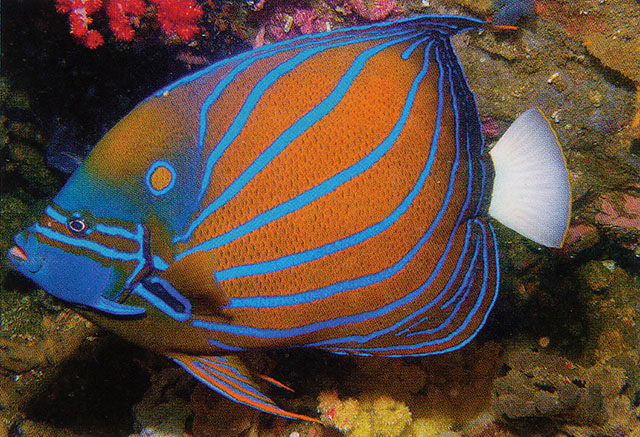| Pomacanthidae (Angelfishes) |
| 45 cm TL (male/unsexed) |
|
reef-associated; marine; depth range 1 - 60 m, non-migratory |
| Indo-West Pacific: East coast of Africa, throughout Indonesia and New Guinea to New Caledonia, north to southern Japan. |
|
Dorsal spines (total): 13-13; Dorsal soft rays (total): 20-21; Anal spines: 3-3; Anal soft rays: 20-20. Description: Juveniles black with alternating white and blue curved well-spaced stripes on the sides. Adults golden brown or orange with well-spaced curved horizontal stripes radiating from the pectoral-fin base area, running along the sides towards the posterior portion of the dorsal fin. Two similar blue stripes run horizontally across the face, one running through the eye, from above the snout to the edge of the operculum. A blue ring is behind and slightly above the edge of the operculum. Caudal fin is white with bright yellow margin (Ref. 4859). Body depth 1.5-1.6 in SL. Scales longitudinal series about 70 (Ref. 90102). |
| Inhabits coastal reefs to at least 30 m (Ref. 9710). Adults often found in pairs inside caves (Ref. 9710, 48636). Juveniles settle in very shallow inshore habitats with short filamentous algae growth on rock or dead coral substrates (Ref. 48636). Feeds on sponges and tunicates (Ref. 48391). Undergoes a complete color transformation from the juvenile to adult stage. Regularly exported, e.g. from Sri Lanka, for the aquarium trade. |
|
Least Concern (LC); Date assessed: 08 October 2009 Ref. (130435)
|
| harmless |
|
Source and more info: www.fishbase.org. For personal, classroom, and other internal use only. Not for publication.

